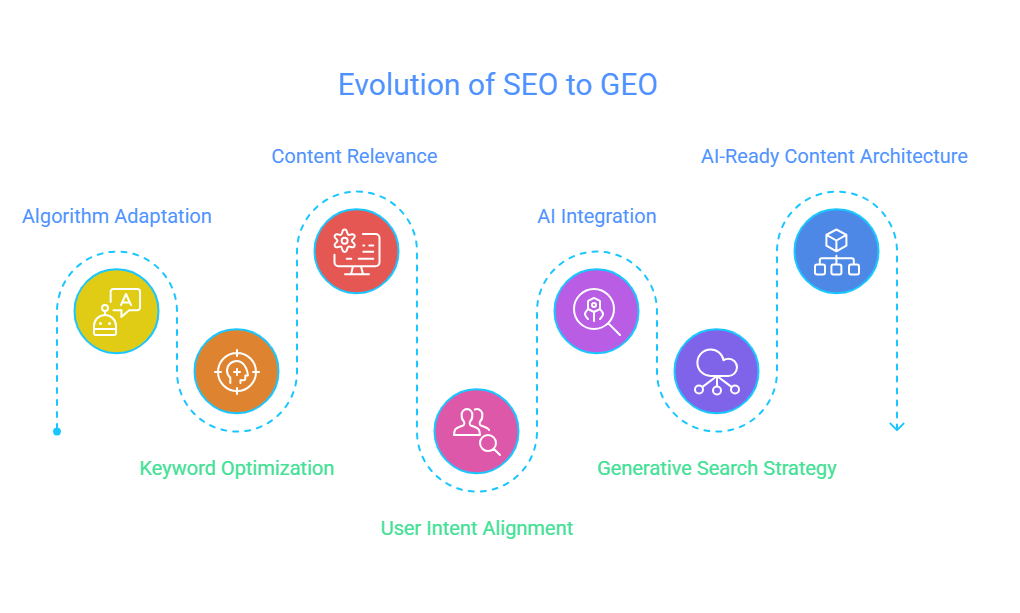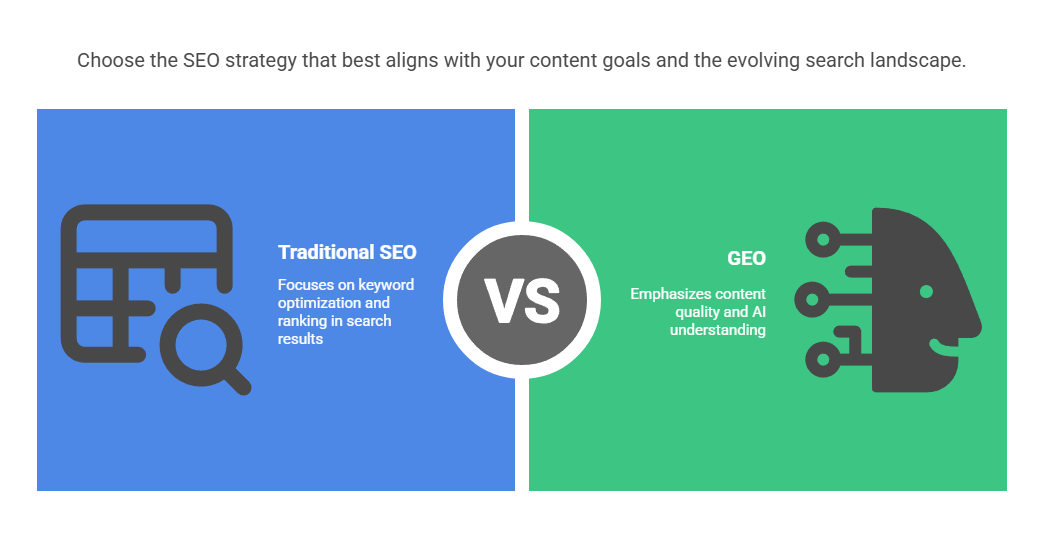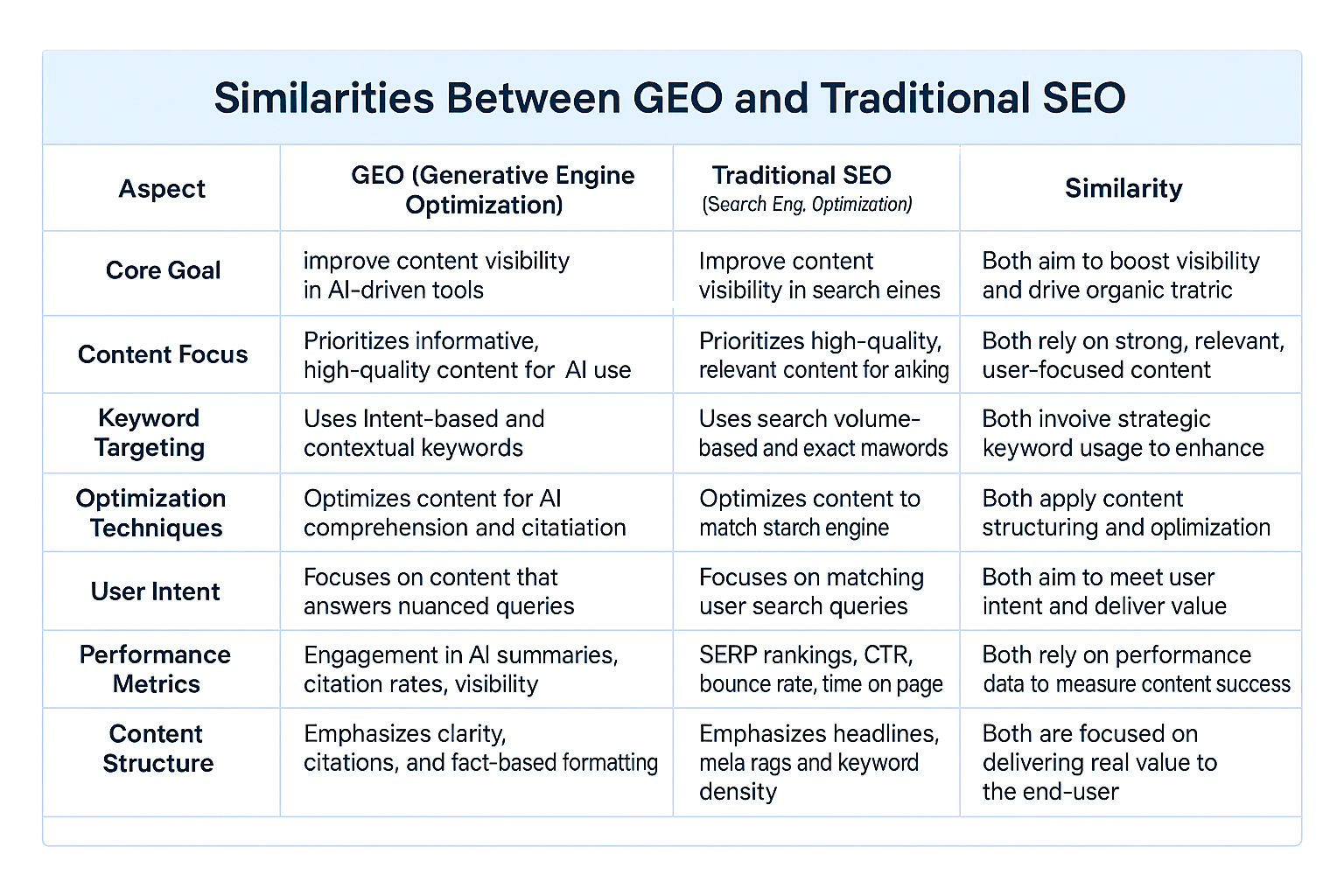You’re putting in the work to create some top-notch content, but it’s not getting the visibility it deserves.
Just when you think things couldn’t get more complicated, AI driven search engines show up.
We get it. But this is the future of search engine optimization. This is the future of branding online. This is the future period.
AI-driven search engines are taking over, and your content can’t just check SEO boxes anymore.
It has to connect with how these AI systems understand, rank, and serve your content to users. It’s all about relevance.
That’s where Generative Engine Optimization (GEO) comes in!
Generative Engine Optimization (GEO) helps your content perform better with AI search engines.
It. It’s similar to ranking on traditional search engines, but not exactly the same.
In the blog below, we’ll answer your GEO questions, how it works, and why it’s becoming a game-changer in modern digital marketing.
Key Takeaways
- Relevance Engineering Over Traditional SEO – Brand Marketers should evolve into “relevance engineers,” focusing on:
- Information retrieval: How do AI search engines find your content and is it relevant to the user’s question? Does your website cluster content into categories and sections that are easy to understand, and how easy is it to read?
- NLP Content Strategy: You need to adopt a confident tone, provide citations, highlight relevant statistics, and ensure readability and clarity.
- Digital public relations (PR): Where can AI engines find your brand being mentioned?
- Structured Data as a Secret Weapon – Embedding key content within structured data formats, such as Schema.org, gives AI search engines the ability to extract and utilize information effectively.
- Embracing Generative Engine Optimization (GEO) – GEO involves tailoring content to be more accessible and valuable to LLMs by:
- Adopting an authoritative tone and providing citations
- Highlighting relevant statistics
- Ensuring readability and clarity
- Influencing Retrieval-Augmented Generation (RAG) Systems – RAG systems can be guided through “semantic trickle” by phrasing content in straightforward subject–predicate–object formats, making it easier for AI to extract meaningful information.
What is Generative Engine Optimization (GEO)?

Generative Engine Optimization (GEO) is about tailoring your content and website specifically for AI-driven search engines. Engines like Google AI Overviews, ChatGPT, and Perplexity.
At its core, GEO helps your content reach more people on more platforms so that more users come to your website. More traffic, more trust, more conversions.
GEO ensures your website isn’t just discoverable, but also well-represented by AI-powered engines that are shaping the future of search.
Recommended Tools and Tactics
- ZipTie: Tracks AI overview visibility across queries
- Profound: Monitors generative search presence
- CrUX + Core Web Vitals: Ensures pages are fast and indexable
- Schema.org: Implements rich structured data
- Google DOJ Documents: Provides insights into Google’s values and priorities
More and more people are using AI-driven search engines, which means that businesses must adapt their digital marketing strategies to include GEO. It’s not just the latest trend, it’s the future of search. Unlike traditional search engines, AI engines focus on contextual relevance.
Traditional search engines are changing… heck they’ve changed a lot in the past 12 months already. But they aren’t slowing down.
Unique Aspects of Generative Engine Optimization

✅ Built for AI comprehension:
Generative Engine Optimization (GEO) uses natural language processing (NLP) to structure content in a way that’s easy for AI to understand, summarize, and present.
✅ Goes beyond keywords & backlinks:
GEO prioritizes relevance, clarity, and trustworthiness over keyword density. You have to prove that you can be trusted through content quality, citations, statistics, sources, authorship, and real Subject Matter Expert insights.
✅ Optimizes for synthesis, not just rankings:
Rather than optimizing solely for SERP position, GEO ensures your content is the kind that AI systems pull into their AI generated responses.
✅ Blends SEO + GEO for maximum reach:
The best strategies combine traditional SEO techniques like keyword research with GEO’s adaptability, ensuring your message gets seen, clicked, and trusted by both people and AI.
As AI-generated search continues to rise, GEO helps ensure your content remains competitive, discoverable, and aligned with evolving user behavior. And hey, that’s exactly what we want.
GEO In The Wake Of The Search Engine Volume Drop

Gartner predicts that search engine volume will drop by 25% by 2026. All thanks to AI chatbots and other virtual agents.
As users are flocking to platforms like ChatGPT, Perplexity, and Google AI Overviews for direct and comprehensive responses. So what? Well that means your content needs to be optimized not just for humans, but for how machines read, retrieve, and respond.
✅ GEO ensures your brand remains visible and trusted in an AI-first world.
✅ It helps your content become the source AI models quote, summarize, and surface.
✅ And it builds a stronger, smarter brand presence, wherever your audience asks questions.
💡 Leading digital marketing agencies are already shifting strategies, building content with GEO principles to thrive in this new search landscape.
If you want your content to shine where search is heading, GEO is the strategy to bet on.
The Natural Evolution of GEO

1. From Keywords to Concepts
- SEO focused on matching keywords to user queries.
- GEO focuses on matching concepts and context to AI model outputs.
Instead of asking, “What keyword do I want to rank for?” GEO asks, “What’s the best way to teach an AI to use my content as the answer?”
2. From Pages to Passages
- SEO traditionally optimized whole pages.
- GEO methods optimize semantic chunks (passages of 50–150 words) so that large language models (LLMs) can easily extract information.
Think: clear headings, concise answers, and logical flow. Every paragraph matters.
3. From SERPs to AI Overviews
- SEO lived and died on blue links in the Search Engine Results Page (SERP).
- GEO competes for inclusion in AI Overviews and generative answer engines like:
- Google SGE
- ChatGPT
- Perplexity
- Bing Copilot
In GEO, your content isn’t just trying to rank, it’s actually trying to be quoted or cited in AI’s response. That’s a whole different ball game.
4. From Optimization to Relevance Engineering
- SEO was about relevant keywords, structure, tags, and links.
- GEO is about training LLMs to recognize your content as trustworthy, structured, and useful.
This includes:
- Structured data (schema)
- Subject-matter expertise
- Cited sources
- Conversational tone with depth
So, What Do You Do Differently With GEO?
- Create AI-friendly content that uses clear subheadings, concise answers, and structured formats.
- Use E-E-A-T principles aggressively (Experience, Expertise, Authoritativeness, Trust).
- Focus on brand search volume and entity recognition.
- Monitor your presence in AI tools, not just in Google SERPs.
- Publish content that AI models want to reference, not just humans.
GEO vs. Traditional SEO: Key Differences

GEO ensures your content is picked up and used by AI-driven tools, not just trying to rank higher in traditional search results. [source]
The focus is on optimizing content for AI-driven search engines like Google AI Overviews, ChatGPT, and Perplexity. You wouldn’t do the same things to boost your rankings as you would with traditional SEO, but they are quite similar.
It emphasizes the quality of your content and how it’s structured. It’s less about playing to the AI algorithms and traditional search engine formats and more about making your content easy for AI to understand and use.
GEO is designed for the new wave of AI-powered searches that don’t just list links – they pull together information from multiple sources and deliver it to intended audiences effectively as AI generated results.
Traditional SEO practices focus on optimization strategies like keyword placement.
GEO vs. Traditional SEO: Key Similarities

Both SEO and GEO are focused on the same big goals: getting your content seen and engaging your audience.
Both approaches rely heavily on unique, relevant content because quality matters.
And that’s the case whether you’re optimizing for AI tools or traditional search engines. It’s all about creating content that meets user expectations and delivers real value. It’s as simple and as difficult as that.
Both also use similar techniques, like keyword targeting and content creation optimization, to improve search rankings.
Traditional SEO tracks keyword performance, is more focused on search volumes and impressing search engine algorithms. On the other hand GEO focuses on helping AI-driven tools understand and use your content effectively.
So, whether you’re going the SEO route or diving into GEO, you’re ultimately working toward the same thing: boosting your website’s visibility and driving more organic traffic.
How Generative AI Engines Work

- Massive Data Training – Generative AI models like ChatGPT and Gemini are trained on vast datasets, powering AI-powered search engines with data from books, articles, and websites.
- Pattern & Context Recognition – AI learns language patterns, improving organic search metrics by providing natural, relevant responses based on context.
- Multi-Source Input – These search technologies pull information from diverse sources and structured data, boosting organic search traffic by delivering accurate and comprehensive responses.
- Powered by Large Language Models (LLMs) – LLMs use machine learning techniques like transformers, helping AI-powered search engines generate relevant, high-quality content.
- Contextual Understanding – AI understands word relationships in context, enhancing organic search metrics by providing human-like comprehensive answers.
- Input Encoding & Output Decoding – User input is processed into structured data, improving SEO and organic search traffic expected through optimized content generation.
- Intelligent Synthesis – AI synthesizes information across multiple sources, creating concise, relevant content that drives other organic search metrics.
- User Intent Matching – AI aligns responses with user behavior and search intent, essential for GEO strategies and improving organic search metrics.
- Search Behavior Influence – As AI understands user needs better, it reshapes organic search and content visibility, boosting search traffic.
- Human-Centric Output – The goal is to generate human-centric content that aligns with user expectations, improving organic search metrics and engagement.
Measuring GEO Performance

To gauge how well your content is performing in AI-driven search results, focus on these indicators:
- Visibility in AI Responses – Monitor how often your content appears in AI-generated answers.
- User Engagement Post-Referral – Assess how users interact with your site after arriving via AI platforms.
- Brand Authority Perception – Evaluate how AI-driven platforms perceive your brand’s authority.
- Utilizing UTM Parameters for AI Traffic – Implementing UTM parameters helps track the source of your AI referral traffic.
- Establishing Benchmarks and Continuous Monitoring – Set initial benchmarks for these metrics and regularly compare them against industry standards.
Future Of Generative Engine Optimization
As AI-driven search engines evolve, search engine optimization tactics like keyword stuffing are becoming less effective. The rise of generative AI has led to a significant shift in how content is created and consumed. According to McKinsey, 65% of organizations now regularly use generative AI, nearly double the adoption rate from the previous year.
The future of GEO lies in continuous adaptation and innovation. By embracing the capabilities of generative AI and aligning content strategies with the evolving landscape, businesses can ensure their content remains visible, relevant, and impactful in AI-driven search results.
As AI and answer engines continue to dominate search engine results pages (SERPs), integrating GEO strategies into your digital marketing strategy is important for staying competitive in an increasingly AI-powered world.
Frequently Asked Questions
How does GEO differ from traditional SEO?
GEO differs from traditional SEO by focusing on content quality and structure for AI platforms, aiming to meet user intent and create better conversational experiences, not just target keywords.
Why is GEO important in modern search?
GEO helps AI platforms deliver more relevant, personalized results by considering location, context, and user intent, ensuring accurate, timely responses.
What are some key strategies for optimizing content for GEO?
To optimize for GEO, use structured data, authoritative content, and language that aligns with AI models, boosting visibility, engagement, and relevance to user intent.
How can I measure the performance of my GEO efforts?
Track GEO performance by monitoring AI visibility, post-referral engagement, brand mentions, and UTM-tagged traffic, ensuring your content meets user intent via AI and answer engines.
My name is Ryan, and I help businesses, small and large, make a lasting impact online.
I am passionate about delivering results and helping my clients succeed. With my expertise in SEO, branding, and marketing, I lead the agency’s efforts to create and implement effective strategies that drive business growth. Our all-inclusive approach sets us apart from other digital media companies and ensures that our clients receive the full range of services they need for online success. If you can think of it, we can build it!
Zulu Shack Creative team members thrive on momentum. Like Zulu warriors, we strive to spearhead your idea with speed and quality.
When I’m not helping my team implement new digital marketing strategies, I enjoy playing music, hosting poker nights, reading Stephen King novels, and spending time with my wife and baby daughter.



